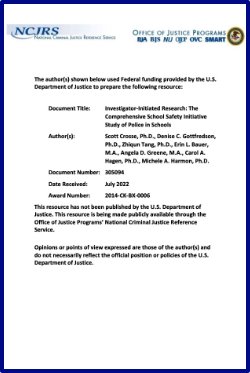Investigator-Initiated Research: The Comprehensive School Safety Initiative Study of Police in Schools
By Scott Crosse, et al.
This is the Final Summary Overview of a study that assessed the effects of school resource officers (SROs) in schools, using a longitudinal design.
The study assessed 1) the effects of SROs on school disciplinary offenses and disciplinary actions and 2) whether the effects of SROs vary by student characteristics, SRO approach, and dose or community and school characteristics. The study collected and analyzed data on public middle and high schools in California that increased SRO staffing levels at a specific time (treatment schools) and on a set of matched schools that did not increase SROs. The increase in SRO staffing levels at the treatment schools resulted from the award of CHP grants to local law enforcement agencies in 2013 or 2014. The grants were intended to support the placement of SROs in schools, and the state had administrative data on schools that could support the analyses planned. Two approaches were used that relied primarily on monthly administrative data on outcomes for assessing the effects of increased SRO staffing levels at the treatment schools resulted from the award of CHP grants to local law enforcement agencies in 2013 or 2014. The outcome measures, based on administrative data, were monthly school-level counts of disciplinary offenses.
-
There were differing reporting requirements for disciplinary offenses by students with and without special needs. The SRO survey, augmented with LEA interview responses for schools that were missing SRO surveys, provided information about SRO activities at their assigned treatment schools. Consistent with prior research on SRO effects, this study found statistically significant intervention effects on weapon-related and drug-related offenses across both follow-up time periods examined and on exclusionary discipline practices at 11 months post-intervention. For these time periods, the mean number of offenses increased for the treatment schools and decreased for the comparison schools, and the mean number of actions decreased substantially less for the treatment schools than for the comparison schools. Differences by school location and student race are noted.
Final report to the U.S. National Institute of Justice, 2020. 13p.


